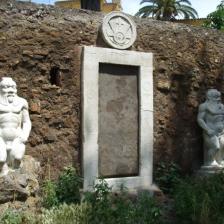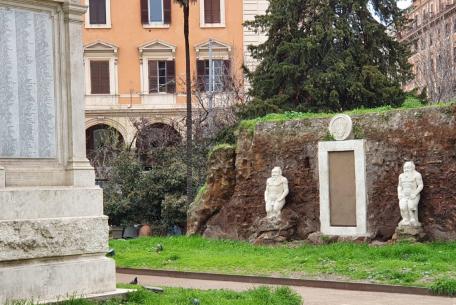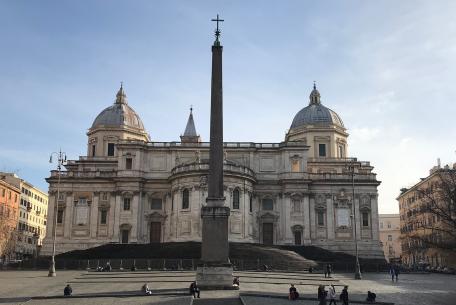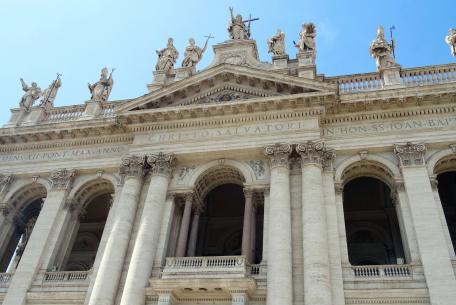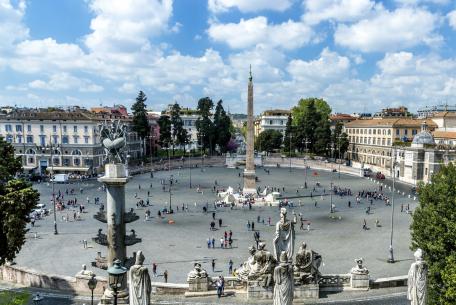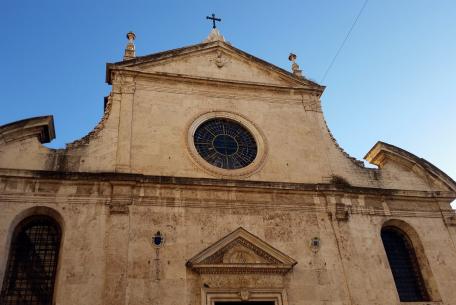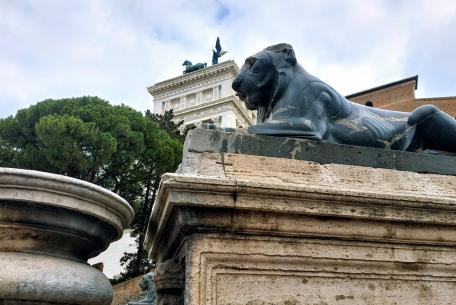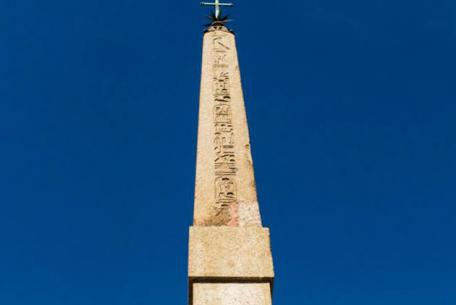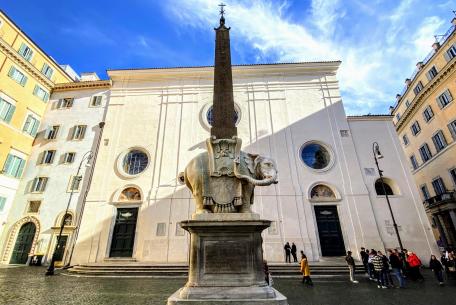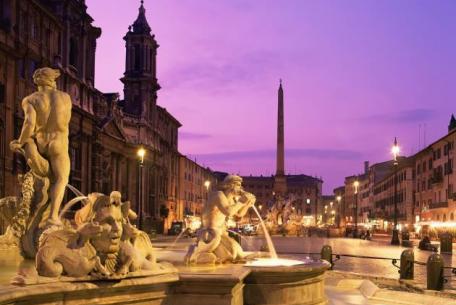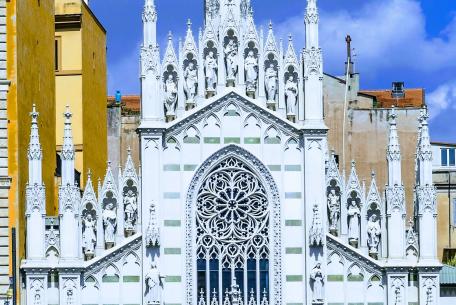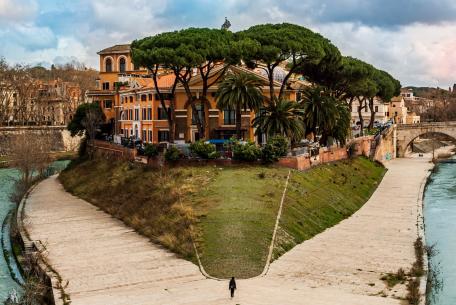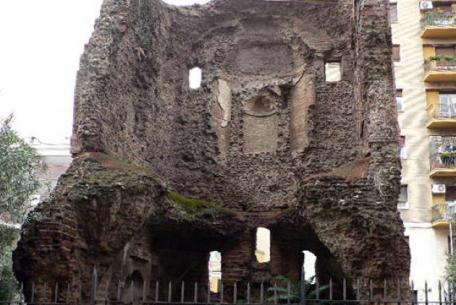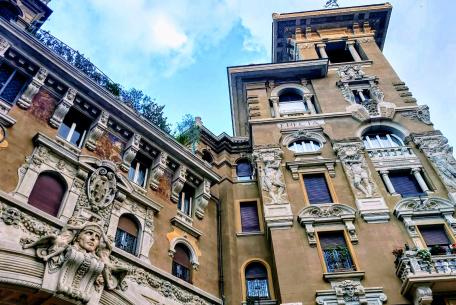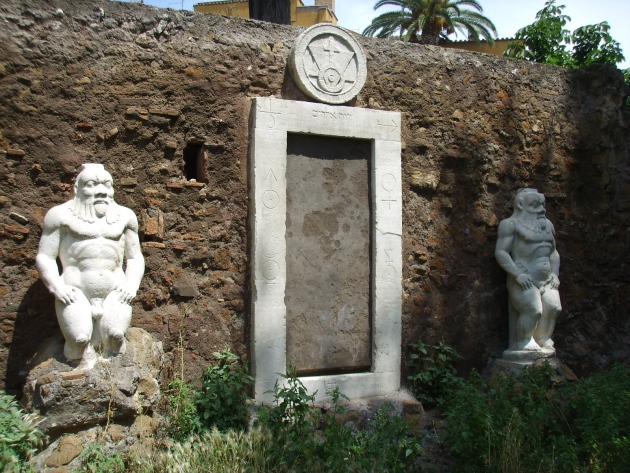
Among the squares, monuments and alleys of the Eternal City are hidden legends, traditions and stories that tell of a magical and mysterious city.
Did you know that in Rome you can open a magic door, look at the devil's chair, try to decipher the symbols in a basilica, eat snails against the witches or recall the goddess Isis? Let's discover the fascinating places that, united by the common thread of esotericism, show us the hidden soul of the capital.
Story #1
If you are passionate about puzzles, the Basilica of Santa Maria Maggiore is the right place for you. Inside, it houses a mysterious square containing five words: Sator, Arepo, Tenet, Opera, Rotas. Do you notice anything strange? The sentence can be read in any direction, left-to-right, right-to-left, top-to-bottom or bottom-to-top. Widespread in various areas of Europe, the magical and ancient Sator Square is curiously present also in the basements of the splendid church already famous for the miracle of the snow.
Nearby, in Piazza Vittorio Emanuele II, there is a magic door now walled up, all that remains of the 17th-century Villa Palombara, built by the Marquis Oddo Savelli of Palombara. The villa was inherited by his son Massimiliano, a well-read man and alchemy lover who set up a laboratory for his experiments. According to legend, a traveller, probably the alchemist doctor Francesco Borri, was housed in the villa during a stormy night in 1680. Entering the gardens, the man began searching for a mysterious herb that could produce gold. The next morning, there was no sign of him, just specks of gold and some enigmatic manuscripts full of symbols. The Marquis had all the formulas, which apparently contained the secret of the philosopher's stone, engraved on the "alchemic gate". Guarded by two statues of the Egyptian god Bes, triangles, symbols of planets, Hebrew and Latin inscriptions are still there, waiting for someone to reveal the arcane.
Not far away, you can reach the Basilica of Santa Croce in Gerusalemme, mysteriously linked with the fate of Gerberto D'Aurillac, who became pope in 999 with the name of Sylvester II. A man of extraordinary knowledge, he was known as the "Wizard Pope" and was one of the most controversial figures in the history of Rome. According to Legend, he became so powerful, thanks to the favours of the devil. It is said that he owned a magic book and built a golden mask able to answer his questions, inside which he had trapped a demon. When he asked the mask about the circumstances of his future death, it would have replied: "You will die by officiating mass in Jerusalem". On 12 May 1003, the pontiff died while celebrating mass in Santa Croce in Gerusalemme and was buried in the nearby Basilica of San Giovanni in Laterano. Coincidence? However, Sylvester II did not cease to surprise. On the occasion of the opening of his tomb, 645 years later, his body was found intact, dissolving in contact with the air and disappearing in a cloud of dust. Only a silver cross and the papal ring remained. Even today, it is said that when a pope dies, a trickle of water comes off his tomb.
In the area of San Giovanni in Laterano, the sacred and the profane met for centuries. Did you know that, in Rome, the feast of 24 June dedicated to Saint John is also called "Night of the witches"?
According to tradition, during the night of the eve, the witches went around the city in search of souls. Thus, people from all the neighbourhoods, by the light of torches and lanterns, used to meet on the lawns of San Giovanni for praying, drinking, making noise with tambourines, trumpets and cowbells and, above all, eating snails in taverns and barracks. Eating snails, whose horns represented discord and concern, meant, removing negativity. The feast ended only at dawn when the Pope went to the Lateran to celebrate mass and, immediately afterwards, to throw gold and silver coins from the loggia of the basilica. The superstitious can go in search of a good plate of snails in a traditional restaurant in the surroundings...
Next to the basilica, there is one of the places with the most relics in the world. Some sacred remains have disappeared, others are closed in silver pointed tabernacles, others are kept elsewhere.
We are talking about the Sancta Sanctorum, which is accessed from the Scala Santa (Holy Stairs). According to tradition, these stairs are the same climbed by Jesus in the palace of Pontius Pilate in Jerusalem in the days of his trial and sent to Rome by Saint Helena. "Non est in toto orbe sanctior locus" meaning "There is no holier place in the world" says the inscription on the altar, on which is the acheiropoietos image (not painted by human hand) of Christ. One of the legends tells that Mary asked the apostle Luke for a portrait of Christ. The future evangelist did not have time to start that he found the image already painted on the canvas, apparently by the hands of the angels. It is also said that the patriarch of Constantinople, to save the work from iconoclastic persecutions, threw it into the sea. From there, it arrived on the banks of the Tiber and was collected by Pope Gregory II, warned by a premonitory dream. Covered with a silver layer during the 13th century, the miraculous relic, whose face painted on a silk cloth is visible, is one of the most enigmatic and venerated icons in the history of the city. In the past, it was carried in procession as a talisman even by the popes. Who painted it?
Story #2
On the Colle degli Ortuli, where the Basilica of Santa Maria del Popolo stands, there is one of the most mysterious places in the city: the tomb of Nero, the suicide dead emperor, whose ashes were buried in a porphyry urn under a walnut tree. Legend has it that the walnut tree, perpetually hovered by crows, was a usual meeting place for some demons, witches, and necromancers. In 1099, following a dream in which the Virgin appeared to him, Pope Pasquale II, particularly superstitious, decided to intervene, because the place was infested with ghosts. The pontiff had the secular tree cut down, scattered the emperor's ashes in the Tiber and built a chapel on the spot where the Domizi Tomb was located. Approaching the main altar of Santa Maria del Popolo and looking up, the most curious can admire the bas-reliefs under the vault that recall the mysterious story.
In the heart of the historic centre, you can discover the testimonies of the oldest and most majestic Egyptian temple in Rome: the Iseo Campense at Campo Marzio, dedicated to Isis, "goddess of a thousand names" and Egyptian divinity of magic, fertility and motherhood. From the first century BC, after the conquest of Egypt by Rome, the charm of the exotic country and the cult of Isis overwhelmingly conquered the capital of the empire, adorned with obelisks, hieroglyphics and symbols. The splendid and imposing sanctuary, built in 43 BC, measured 240 x 60 meters and was restored and embellished over the centuries by many emperors. Following the edict of Constantine and the destruction of the temple, many significant remains were reused. The obelisks in Piazza della Rotonda, Piazza della Minerva and Piazza Navona, the large marble foot in via del Pie 'di Marmo, the lions of the Cordonata of the Capitol, the talking statue "Madama Lucrezia" and the statuette of a cat on the facade of Palazzo Grazioli are some of the silent stone testimonies of the charming goddess and her sumptuous temple, outlined in the centre of the capital, indifferent to the passage of centuries and changes.
"At Purgatory art thou now arrived" would say the great Dante Alighieri welcoming us in the neo-Gothic church of Sacro Cuore del Suffragio, along the Tiber, a stone's throw from Castel Sant'Angelo. Inside, there is, in fact, the evocative Museum of the souls of Purgatory, established by the French missionary Victor Jouet, following the events of 15 November 1897, when a mysterious fire broke out in the Rosary Chapel. The priest and many of the believers present saw a suffering human face in the flames which, after extinguishing the fire, remained enigmatically imprinted on the wall.The image was identified as that of a suffering soul of purgatory, and it was taking on a more serene expression with the intercession actions. Because of the event, Father Jouet decided to travel around Europe in search of testimonies of the afterlife of deceased and contacts with living relatives, collecting extraordinary fingerprints, original or photographed documents, signs and manifestations of all kinds. Mysterious "handprints of fire" on fabrics, cassocks, skullcaps, breviaries, nightgowns and wooden tablets reveal the apparitions in the presence of relatives and religious. The manifestations happened for requesting prayers, masses of suffrage or, as in a particular case in 1879, from the concern of a Belgian woman for the dissolute life led by her son. Behind the steeples and the marble whiteness of the church so-called "little Milan Cathedral ", the fans of the occult can "study" the enigmatic traces of the "little" purgatory.
A romantic island has been rising for centuries in the centre of the Tiber, between the two sides of the Ancient Jewish Ghetto and the Rione Trastevere. It is the curious ship-shaped profile Tiberina Island. According to tradition, around 291 BC, while Rome fell prey to a terrible plague epidemic, a ship with ten sages sailed towards Epidaurus, a city sacred to the Greek god of medicine Aesculapius, to ask for help. During the propitiatory rites, a huge snake suddenly appeared and leaving the temple, repaired on the Roman ship. Interpreted as a divine sign, the ship quickly returned to Rome and, close by the island, the snake descended into the Tiber, swam to the Tiberina Island and disappeared into the vegetation, indicating the exact point for the construction of the temple dedicated to the god. After the inauguration of the temple, the city was miraculously saved from the plague. The temple became a sacred hospital, in which religious rites and healings alternated. The ancient medical vocation of the island continues today with the "Fatebenefratelli" hospital and the Israelite hospital. On the remains of the sanctuary dedicated to Aesculapius, the Church of San Bartolomeo all'Isola was later built. In memory of the miracle, the island was given the shape of a ship, with bow, stern and main mast represented by an obelisk. The hypnotic bas-relief of a snake coiled around the god's sceptre emerges from one of the arches under Pons Fabricius to recall the event.
Story #3
In the so-called "quartiere Africano" (African district), in today's Elio Callistio square, there is the Devil's Chair, the ruin of an ancient funeral monument, probably of a freedman of Emperor Hadrian. The building, which in ancient times stood on a hill along the ancient Via Nomentana, was erected in the mid-2nd century AD on two levels. It was called "Devil's Chair" following the collapse of the facade when the remains took on the appearance of a chair with armrests. In medieval times, when the monument was located far from the city and abandoned to itself, the many eerie legends were born: in fact, people began to believe that it was a demonic place, as well as the throne of Satan, placed right behind the throne of the Pope. The site used to be the usual refuge for homeless people and shepherds who lit fires at night, making the monument take on an even more gloomy appearance due to the play of flames and shadows. In 1300, then, some wrote their wishes on the wall, to make them come true, others scraped fragments of bricks to use in magic potions. It is also said that in 1800 a shepherd named Giovanni, looking for a sheep he lost, approached the "Chair" and was suddenly endowed with extraordinary powers, with which he treated people by preparing miraculous filters precisely with the dust obtained from the monument. The legends, however, do not end here: it seems that in a point of the "Chair", you can read the word "kabala", a kind of magic formula engraved on the stones of the ruin by the alchemist Zum Thurm. Beating with a closed fist on the bricks and saying "I want to change history", according to the tradition it was possible to change one's own life ...
Located in the splendid park of Villa Torlonia, Casina delle Civette (The House of the Owls) has a hypnotic, fairy and gothic charm. The building was built in 1908, radically transforming the 19th-century "Swiss Cabin", inspired by Prince Giovanni Torlonia, an unsociable man who loves esotericism. Between 1916 and 1920, the eclectic Prince remodelled the building to the point that it became a fairy-tale Liberty style expression, with loggias, arcades, turrets, majolica decorations and coloured glass windows. As soon as you cross the threshold, a world populated by fantastic animals, mysterious creatures and esoteric symbols is revealed to the visitor: butterflies, comets, roses, clovers, lighthouses, seagulls, female figures, satyrs, phoenixes, cyclamens, birds and, on everything, the owl, repeated in every corner of the residence. The nocturnal bird, since ancient times an emblem of magic and clairvoyance, became a sort of obsession for Giovanni Torlonia, who wanted it in the decorations, in the furniture, in the delightful windows, in the lunettes, on the capitals. The most representative location of the dark personality of the prince is the bedroom, full of elements related to the occultism and the fascinating nocturnal animals: from the bed with knobs to the lamps, from the jug for water to the wallpaper, these last unfortunately lost. At the centre of the ceiling, remains a large rose representing a mysterious flight of bats with black wings spread out against the background of a starry blue sky.
A short distance from Villa Torlonia, behind piazza Buenos Aires, is Quartiere Coppedè, which takes its name from the eclectic architect Gino Coppedè. Designed and built from 1915 to 1927, the complex of 26 buildings and 17 villas is an incredible pastiche of Art Decò, Liberty style, with influences of Greek, Gothic, Baroque and medieval art. An imposing arch, with a large wrought iron chandelier and richly decorated with masks, ephebes and frescoes with medieval knights, represents the monumental entrance to the area and connects the two Palaces of the Ambassadors. These buildings, with their facades and turrets adorned with coats of arms, mythological characters, eagles and a votive shrine, are the perfect prelude to what awaits you entering the bizarre neighbourhood.After passing the suggestive entrance, you find yourself in Piazza Mincio, the heart of the area, at the centre of which stands the Fountain of the Frogs, precisely embellished by 12 sculptures of frogs. All the buildings are rich in elements and symbols that evoke mythology, tradition and mystery: the Assyrian-Babylonian inspired Palazzina del Ragno, taking its name from the large decoration with the spider placed above the entrance door, adorned with the word "Labor" and a painting depicting a knight between two gryphons; the fabulous Villino delle Fate, which between the play of light and shadow, is a triumph of decorations of Roman gods, coats of arms, fruit pots, suns, ladies and knights, sundials, the tree of life and the portraits of the great poets Dante and Petrarca; "Palazzo senza Nome" (Unnamed Palace) also known as Palazzo Hospes Salve, on which the Latin epigraph "INGREDERE HAS AEDES QUISQUIS ES AMICUM ERIS HOSPITEM SOSPITO" (Enter this house whoever you are; you will be a friend. I protect the guest) is engraved. Are you ready to cross the imaginary border, leaving the energy of the city to enter into a fairytale and magical fantasy?
 Condividi
Condividi












































